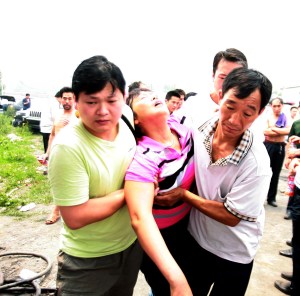
Associated Press
China’s coal mining industry saw another disaster today when an mine explosion in the central province of Henan killed 46 miners on the spot. The mine, located in one of China’s biggest coal producing regions, was allegedly operating illegally, according to the government-run Xinhua news agency. Though the cause of the blast is still not known, 72 miners were trapped after explosives blew up in the mine. Twenty-six escaped.
The event brings to mind, strangely enough, a better moment for the Chinese coal industry, when 115 miners were dragged alive out from a flooded mine in Shanxi province in April after spending over a week underground. The global media was captivated by the scenes of that rescue, as my colleague Austin Ramzy in Beijing wrote about, especially as it coincided with the worst U.S. mining disaster in decades. As Austin points out, the events in the Upper Big Branch mine in West Virginia this year were traumatic not only because of the loss of 29 lives, but the U.S. coal mine safety record has long been one of the best in the world.
In China, such disasters occur with depressing regularity, but that doesn’t make them any less tragic. When I first moved to Hong Kong in 2007, I was shocked to read the constant tally in daily news blurbs of the very frequent — and very deadly — mining accidents unfolding next door on the mainland. That, as it turned out, was shaping up to be a particularly bad time. In 2008, 3,215 people were killed in China’s coal mines; by 2009, the number dropped to 2,631.
Still, the 2009 average of more than 6 deaths a day is nothing to brag about, and this year isn’t looking so great either. The “miracle” rescue in April was an incredible thing to see, less because of the official response than because of the will and instinct of the workers who survived and the relief of the hundreds of family members who were spared a personal tragedy. But dozens of workers did not make it out alive from that blast. And on May 14, over 20 workers were killed in a mine blast in Guizhou province. On May 18, 10 workers were killed in a gas blast in a coal mine in Shanxi, and on May 30, 17 coal miners were killed in another explosives accident in a mine in southern Hunan province. Today, that list goes on.
Beijing has been trying to step up responsibility for mine management. It’s also been investing in cleaner coal technologies and renewable energy sources like wind, solar and geothermal to ease pressure on its mines [EM] and to lose the distinction of being the world’s largest annual greenhouse gas emitter. But that’s a long road: As recently as 2007, China was still consuming 41% of the world’s coal, and as of 2005, nearly 63% of the nation’s energy demand was coal. Demand for coal is only projected to go up from here — in a recent report from the Pew Center for Climate Change, it could be triple its coal power capacity from 2005 numbers to 2030.
Our conversation about our global dependence on coal is so often cast solely in terms of what the energy source is doing to our air, our oceans and our land. But just like an energy disaster unfolding the other side of the globe, it’s all t0o easy to open a paper here and find the places where we can what it’s is doing to our families.


